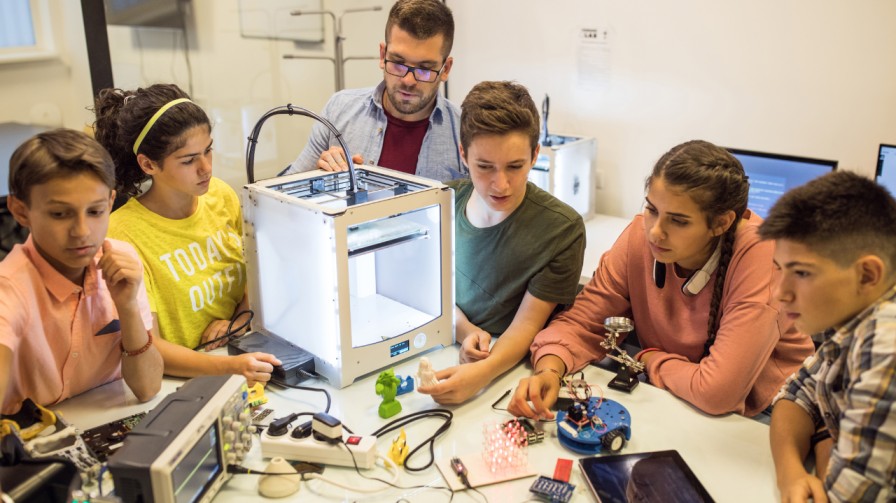Introduction
Education Loves All Tech
In an era where technology and education are increasingly intertwined, it’s essential to understand how this synergy can be harnessed to enhance learning and foster innovation. So the relationship between technology and education is not just beneficial but necessary, as it opens doors to new methods of learning, understanding, and creating. In this comprehensive exploration, we delve into the myriad ways technology is revolutionizing education.
Integrating Technology in Classrooms: A New Era of Learning
The traditional classroom has been transformed with the integration of technology. Interactive whiteboards, digital textbooks, and online resources provide dynamic learning experiences. These tools not only make learning more engaging but also cater to different learning styles, ensuring that each student can learn in a way that’s best for them.
E-Learning Platforms: Bridging Geographical Gaps
Online learning platforms have made education accessible to everyone, everywhere. These platforms offer a range of courses, from basic literacy to advanced degrees, making quality education available regardless of location. The flexibility of e-learning accommodates diverse schedules and commitments, making it an ideal solution for lifelong learners.
The Impact of AI on Tailoring Educational Experiences
Artificial Intelligence (AI) in education is a game-changer. AI-driven programs can analyze a student’s learning style and performance, tailoring the educational content to their needs. This personalized approach ensures that students are neither bored by too-easy material nor overwhelmed by content that’s too challenging.
Virtual Reality: Bringing Subjects to Life
Virtual Reality (VR) in education offers an immersive learning experience. Whether it’s walking through historical sites or diving into the human bloodstream, VR makes learning vivid and exciting. Because this technology provides a unique way to experience and understand complex subjects.
Gamification: Making Learning Fun and Effective
Gamification in education involves using game-design elements in learning environments. This approach increases engagement and motivation, making learning more enjoyable and effective. By turning education into a more game-like experience, students are more likely to retain information and stay interested in the subject matter.
The Importance of Coding and Computational Thinking
In the digital age, understanding the basics of coding and computational thinking is as important as reading and writing. Schools are increasingly incorporating coding into their curricula, recognizing its value in developing problem-solving skills and logical thinking.
Collaborative Tools: Fostering Teamwork and Communication
Technology has introduced various collaborative tools that facilitate group work and communication. Platforms like Google Classroom and Microsoft Teams allow students to work together seamlessly, regardless of their physical location. This collaboration prepares students for the modern workforce, which increasingly relies on digital communication and teamwork.
Data Analytics: Shaping the Future of Education
Data analytics in education is a powerful tool. By analyzing trends and patterns in student performance, educators can make informed decisions about teaching strategies and curriculum design. This data-driven approach ensures that educational content remains relevant and effective.
Preparing Students for a Tech-Driven Future
As technology continues to evolve, it’s crucial that education systems keep pace. Preparing students for a tech-driven future means not only teaching them how to use technology but also how to innovate and think critically about its role in society.
FAQs on Education Loves All Tech
- Why Education Systems Depend Heavily on Technology: Education systems are increasingly relying on technology due to its ability to make learning more accessible, engaging, and tailored to individual needs. It prepares students for a future where technology is integral.
- Role of Technology in Education: Technology enhances educational experiences through interactive tools, online resources, and personalized learning. It facilitates remote learning and prepares students for a digital future.
- Nature of Educational Technology: It is dynamic and user-focused, incorporating various tools and methods to improve learning and teaching. It adapts to the evolving needs of learners and educators.
- Meaning of Technology Education: It’s about learning to use technology ethically and effectively, so understanding its societal implications, and harnessing it for innovation and problem-solving.
- How Technology Changes Classrooms: Technology makes classrooms more interactive and engaging with digital tools, catering to different learning styles.
- Technology’s Role in Personalized Education: Yes, because technology enables personalized learning through adaptive software and AI, tailoring content to individual student needs.
- Long-term Benefits of Technology in Education: It prepares students for a digital future, enhances learning accessibility, and develops essential skills like digital literacy and problem-solving.
Conclusion
Education Loves All Tech
The fusion of technology and education is creating a world where learning is more accessible, engaging, and tailored to individual needs. So by embracing this integration, we are preparing a generation of learners who are equipped to thrive in a rapidly changing world. If you want more information about this topic just visit the link. Thankyou so much for being here!
Discover More Blogs:

